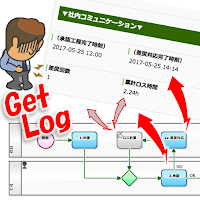Productivity declining due to mistakes
For those who make approvals, processing of "Sending back" is annoying.Instead of reading the contents of an application and giving approval on it without saying anything (It will take 3 minutes), he or she must write a "reason for sending back" which costs 10 more minutes. (You don't dare to reject without a word, do you?) And if that was for "Point out simple mistake or typo", and if that occurred five, ten times a day, it may make you depressed.
And of course, the time to get home will be delayed by 1 hour and 2 hours.
Mistake occurrence rate lowered by system improvement
Mistake in "Date", "Amount", or "Customer name".The applicants don't dare to make mistake on purpose. Basically, we would like to consider how to lower occurrence rate by "improving the Business Process Definition".
- Improve "notes" and "input check" on input screen
- Add "reviewing step" by colleagues to Workflow
[Base flow of Request type process-Script]













